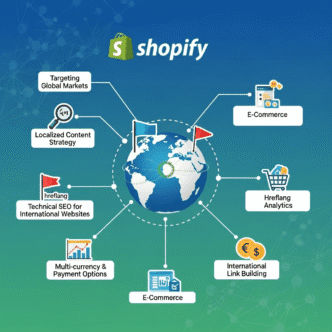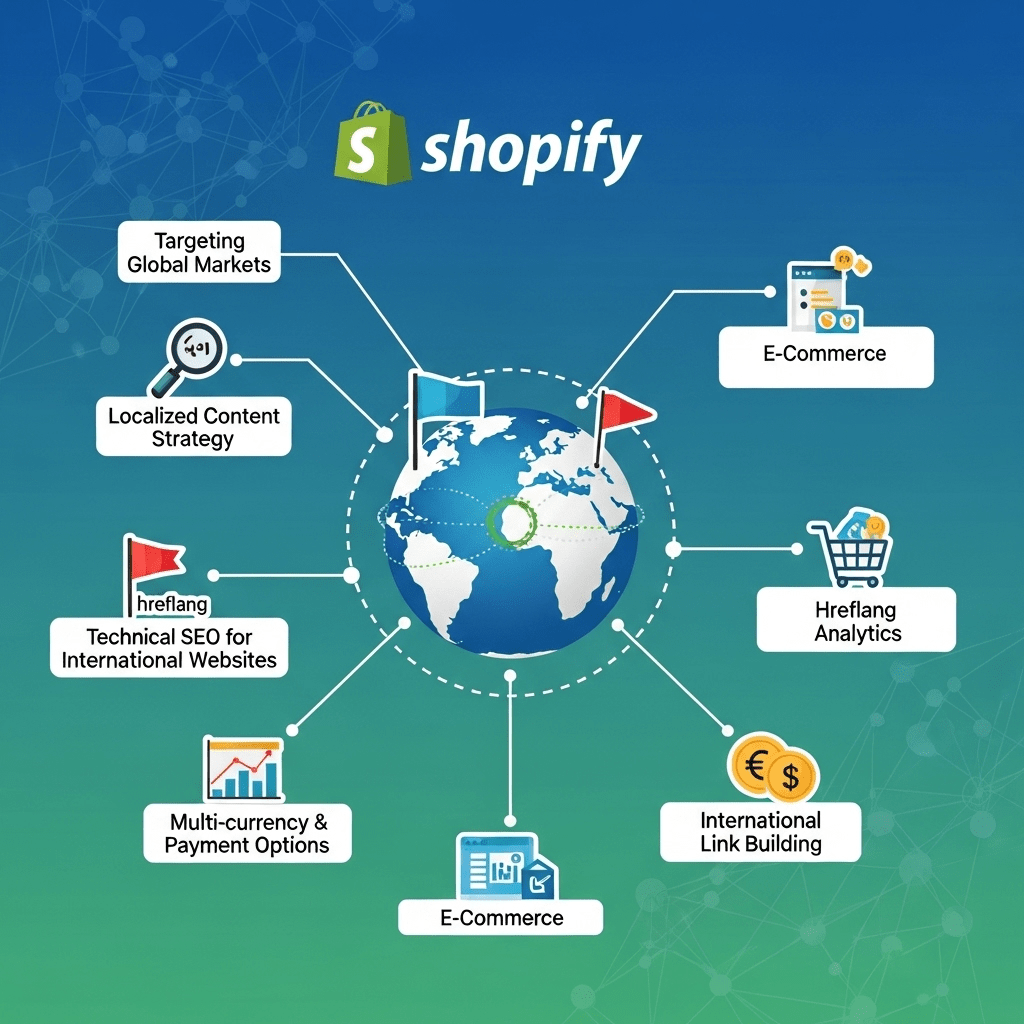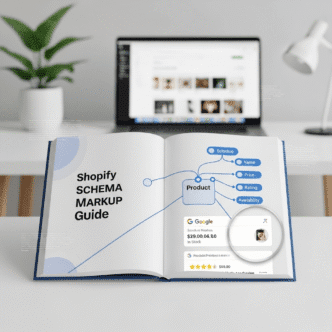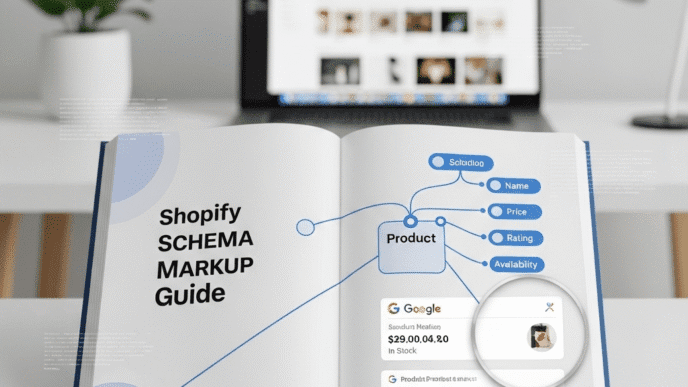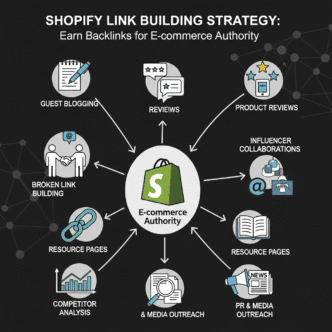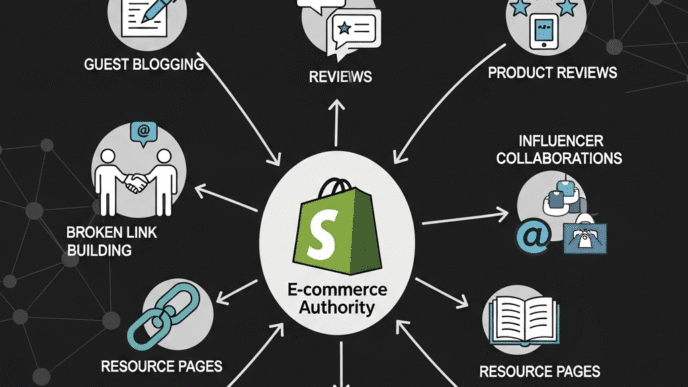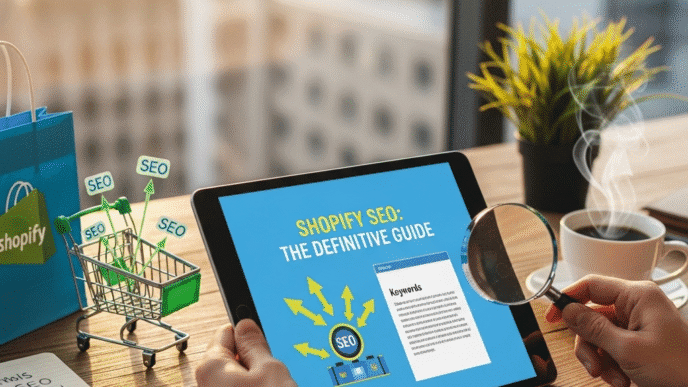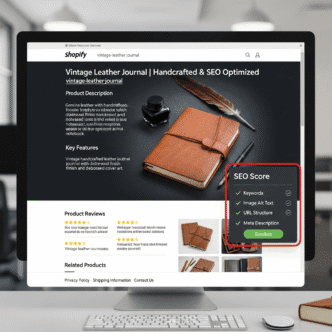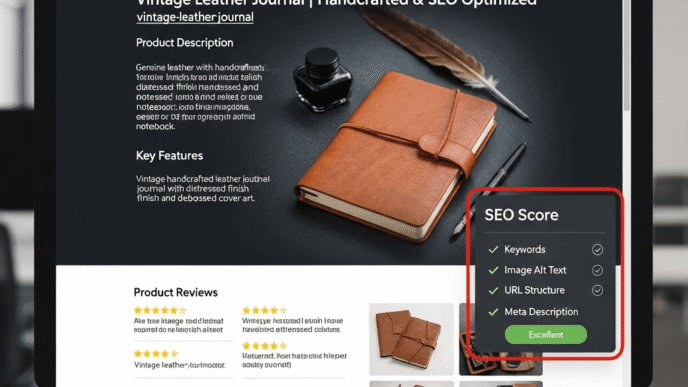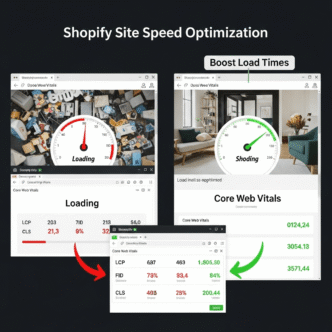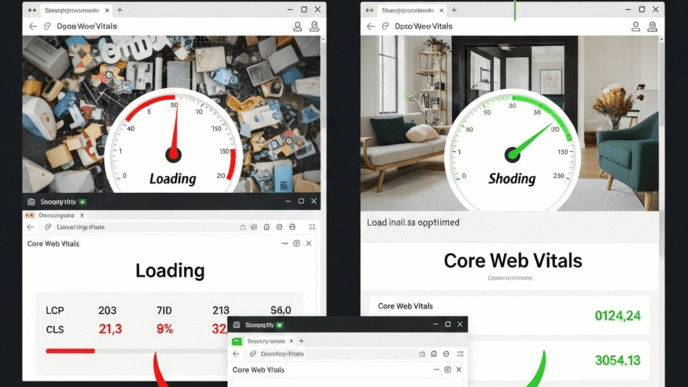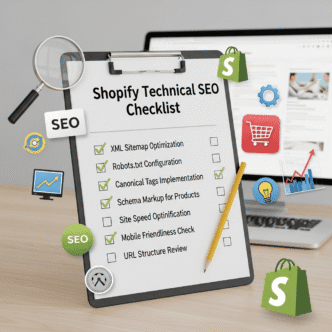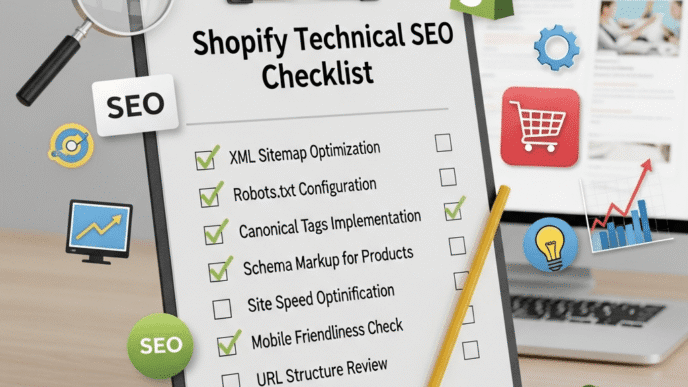Your Shopify store is crushing it in the US. Sales are solid. Reviews are great. But here’s what’s keeping you up at night: you’re watching potential customers from Germany, France, Japan, and Australia land on your site, struggle with English descriptions, see prices in the wrong currency, and bounce straight to local competitors.
That burning sound? It’s money. Literally on fire.
Here’s the brutal truth: Shopify international SEO isn’t just about translating your product descriptions into Spanish and calling it a day. It’s about technical optimization, proper hreflang tags, seamless multi-currency implementation, and strategic geotargeting that makes Google understand you’re actually serving those international markets.
Most Shopify store owners dream about global expansion but fumble the execution. They create half-baked international versions that Google ignores, customers distrust, and competitors laugh at. Meanwhile, smart stores are properly optimizing for international markets and printing money in 47 countries.
In this comprehensive guide, I’ll show you exactly how to optimize Shopify store for international markets and languages—from technical setup to content localization to currency optimization. No theory, no guesswork. Just proven strategies that work in 2025.
Let’s turn your single-market store into a global empire.
Table of Contents
ToggleWhy Is International SEO Critical for Shopify Growth?
Let me hit you with some perspective: the US represents only 4.2% of the world’s population. If you’re only targeting English-speaking Americans, you’re ignoring 95.8% of potential customers.
Shopify international SEO unlocks massive opportunities:
Untapped Markets: Countries like Germany, France, Japan, and Brazil have huge e-commerce markets with less competition than the US.
Higher Profit Margins: International customers often pay premium prices, especially for US-based brands they can’t easily access locally.
Business Diversification: Multiple markets mean reduced risk. If one economy tanks, others keep you afloat.
Competitive Advantage: Most Shopify stores never bother with proper international SEO. Do it right, and you dominate.
According to Common Sense Advisory research, 76% of online shoppers prefer to buy products with information in their native language, and 40% will never buy from websites in other languages. That’s not a preference—it’s a requirement.
Real example: A specialty coffee roaster expanded from US-only to targeting Canada, UK, Germany, and France with proper international SEO. Within 18 months, international sales represented 43% of total revenue—$780,000 annually from markets they’d previously ignored.
For foundational Shopify SEO strategies before going international, start with our definitive Shopify SEO guide.
What’s the Difference Between Translation and Localization?
This is where most stores fail. They translate. But translation isn’t localization, and Google knows the difference.
Translation: Word-for-Word Conversion
Translation converts text from one language to another. “Blue running shoes” becomes “Blaue Laufschuhe” in German.
Problems with Translation-Only:
- Doesn’t account for cultural differences
- Misses idioms and colloquialisms
- Ignores local search behavior
- Doesn’t adapt to local preferences
- Often sounds robotic or unnatural
Localization: Complete Market Adaptation
Localization adapts your entire store for a specific market:
- Language translation (done naturally)
- Currency conversion
- Local payment methods (iDEAL in Netherlands, Klarna in Europe)
- Cultural adaptation (colors, images, messaging)
- Local search keywords (not just translated keywords)
- Region-specific sizing (US vs UK vs EU sizes)
- Local regulations and tax display
- Appropriate imagery and examples
Example of the Difference:
Translation: “Free shipping on orders over $50”
German translation: “Kostenloser Versand bei Bestellungen über 50 $”
Localization: “Kostenloser Versand bei Bestellungen über 45 €”
(Uses Euros, adjusts threshold for local market expectations)
Pro Tip: According to CSA Research’s “Can’t Read, Won’t Buy” study, 65% of consumers prefer content in their language even if it’s poor quality, but 73% want product reviews in their language. Localization goes beyond just translating—it’s about creating a genuinely native experience.
How Does Shopify Markets Work for International Selling?
Shopify Markets is Shopify’s official solution for global expansion. Understanding it is crucial for international SEO.
What Shopify Markets Does
Centralized Management: Manage all international markets from one Shopify admin.
Domain/Subdomain Options:
- International domains:
yourstore.de,yourstore.fr - Subfolders:
yourstore.com/de,yourstore.com/fr(most common) - Subdomains:
de.yourstore.com,fr.yourstore.com
Automatic Currency Conversion: Show prices in local currencies based on visitor location.
Market-Specific Pricing: Set different prices per market (account for shipping, taxes, local competition).
Language Translation: Integrate with translation apps for multi-language content.
Local Payment Methods: Enable region-specific payment options.
Hreflang Handling: Automatically generates hreflang tags (when configured correctly).
Shopify Markets Plans
| Plan | Markets | Cost | Best For |
|---|---|---|---|
| Basic Markets | Single market | Included | Testing international |
| Shopify Markets | Multiple markets | Included (Plus required for some features) | Active international selling |
| Markets Pro | Advanced features | 3.5% of international orders | High-volume international |
SEO Implications of Market Structure
Best for SEO: Subfolders (yourstore.com/de)
- Consolidates domain authority
- Easier to manage
- Google understands structure well
- Most common approach
Good for SEO: International Domains (yourstore.de)
- Strongest local market signals
- Best for serious country-specific focus
- Requires more management
- Builds separate domain authority per country
Okay for SEO: Subdomains (de.yourstore.com)
- Google treats somewhat separately from main domain
- More complex to manage
- Less recommended in 2025
External resource: Shopify’s official Markets documentation provides detailed setup instructions.
What Are Hreflang Tags and Why Are They Non-Negotiable?
Hreflang tags are the secret sauce of Shopify international SEO. Get them wrong, and Google serves the wrong language/country version to users. Get them right, and you dominate international search.
What Hreflang Tags Tell Google
Hreflang tags specify:
- Language: What language is this content in? (e.g., English, German, French)
- Region: What country/region is this content for? (e.g., US, UK, Germany)
- Alternative Versions: What other language/region versions exist?
Hreflang Tag Format
<link rel="alternate" hreflang="en-us" href="https://yourstore.com/" />
<link rel="alternate" hreflang="en-gb" href="https://yourstore.com/gb/" />
<link rel="alternate" hreflang="de-de" href="https://yourstore.com/de/" />
<link rel="alternate" hreflang="fr-fr" href="https://yourstore.com/fr/" />
<link rel="alternate" hreflang="x-default" href="https://yourstore.com/" />
Breaking it down:
en-us: English language, United Statesen-gb: English language, United Kingdom (different from US!)de-de: German language, Germanyx-default: The default version for users not matching any specific target
Common Hreflang Mistakes
❌ Missing x-default: Always include a default version for unmatched visitors
❌ Inconsistent Implementation: All versions must reference each other bidirectionally
❌ Wrong Language Codes: Use ISO 639-1 language codes (en, de, fr, not eng, ger, fre)
❌ Wrong Country Codes: Use ISO 3166-1 Alpha 2 country codes (US, GB, DE, not USA, UK, GER)
❌ Absolute URLs Only: Hreflang requires full URLs with https://
❌ Forgetting Self-Reference: Each page must include hreflang pointing to itself
How Shopify Markets Handles Hreflang
Good News: When properly configured, Shopify Markets automatically generates hreflang tags for your international markets.
Important: Verify they’re actually there and correct. View source on your international pages and check for hreflang tags.
Tools to Validate Hreflang:
- Google Search Console (International Targeting report)
- Hreflang Tags Testing Tool (technical-seo.com)
- Screaming Frog SEO Spider (crawl and audit)
Pro Tip: According to Aleyda Solis, international SEO expert, incorrect hreflang implementation is the #1 technical mistake in international SEO. Google Search Console will show hreflang errors—check it monthly and fix issues immediately.
For comprehensive technical SEO beyond hreflang, check our Shopify SEO guide.
How Do You Conduct International Keyword Research?
Keyword research for international markets isn’t just translating your English keywords. Search behavior varies dramatically by country and language.
The International Keyword Research Process
Step 1: Understand Local Search Behavior
People in different countries search differently:
- US: “running shoes”
- UK: “trainers” or “running trainers”
- Australia: “runners”
- Germany: “Laufschuhe”
These aren’t just translations—they’re different search terms entirely.
Step 2: Use Local Keyword Tools
| Tool | Best For | Coverage |
|---|---|---|
| Google Keyword Planner | Any country Google operates | Global, country-specific |
| Ahrefs Keywords Explorer | Comprehensive data | 170+ countries |
| SEMrush | Competitive analysis | 140+ countries |
| Ubersuggest | Budget option | Most major markets |
| Local Google Autocomplete | Free insights | Any market |
Step 3: Research in the Target Language
Don’t research in English and translate. Research WITHIN the target market:
- Set Google to the target country
- Use VPN to search from that location
- Check autocomplete suggestions in target language
- Analyze local competitors’ keywords
Step 4: Consider Search Engine Differences
Not everywhere uses Google:
- China: Baidu (different SEO rules entirely)
- Russia: Yandex (significant market share)
- South Korea: Naver (unique algorithm)
- Czech Republic: Seznam (local favorite)
If targeting these markets, research their specific SEO requirements.
Step 5: Map Keywords to Search Intent
Search intent varies by market:
- Germans often research more thoroughly before buying
- Americans search with higher purchase intent
- Japanese users often use different search patterns (more specific, longer queries)
Localized Keyword Examples
Product: “Organic Baby Food”
| Market | Keyword | Monthly Searches | Notes |
|---|---|---|---|
| US | organic baby food | 18,100 | High competition |
| UK | organic baby food | 4,400 | Use “mum” not “mom” |
| Germany | Bio Babynahrung | 2,900 | “Bio” = organic |
| France | alimentation bio bébé | 1,900 | Different structure |
| Spain | comida orgánica bebé | 1,300 | Growing market |
Notice these aren’t just translations—search volumes differ, competition varies, and local terminology matters.
Pro Tip: According to Moz’s international SEO research, 60% of international keywords have completely different search volumes than their English equivalents. Don’t assume popularity translates across borders.
How Do You Structure URLs for International Stores?
Your URL structure is fundamental to international SEO success. Choose wrong, and you’re fighting uphill battles forever.
URL Structure Options Compared
| Structure | Example | SEO Pros | SEO Cons | Best For |
|---|---|---|---|---|
| Subfolders | yourstore.com/de/<br>yourstore.com/fr/ | Consolidates authority<br>Easy to setup<br>Google understands well | All markets share domain authority | Most stores (recommended) |
| ccTLD (Country Domains) | yourstore.de<br>yourstore.fr | Strongest local signals<br>Users trust local domains | Expensive<br>Separate authority per domain<br>Complex management | Serious market focus |
| Subdomains | de.yourstore.com<br>fr.yourstore.com | Isolates markets | Google treats as separate sites<br>Dilutes authority<br>Complex | Rarely recommended |
| Parameters | yourstore.com?lang=de | Easy implementation | Terrible for SEO<br>Don’t use | Never (seriously, never) |
The Subfolder Approach (Recommended)
Structure:
- US/Default:
yourstore.com/ - Germany:
yourstore.com/de/ - France:
yourstore.com/fr/ - UK:
yourstore.com/uk/oryourstore.com/gb/
Benefits:
- All markets benefit from your main domain’s authority
- Easy to manage from one Shopify account
- Clear structure for users and search engines
- Shopify Markets supports this natively
Implementation with Shopify Markets:
- Enable Shopify Markets
- Add target countries/regions
- Configure language per market
- Shopify automatically creates subfolder structure
The ccTLD Approach (For Serious Expansion)
When to Use:
- Dedicating serious resources to specific markets
- Building separate teams per country
- Want strongest possible local signals
- Have budget for multiple domains and marketing
Challenges:
- Each domain needs its own SEO efforts
- Link building required per domain
- Higher maintenance and costs
- Domain registration complexities
Example: A luxury watch brand targeting Germany seriously might use yourstore.de with German hosting, German customer service, German marketing—treating it as a genuinely separate German business.
URL Best Practices
✅ Use hyphens, not underscores: running-shoes not running_shoes
✅ Keep URLs descriptive: yourstore.com/de/laufschuhe (German for running shoes)
✅ Don’t mix languages in URLs: Either full English or full German, not yourstore.com/de/running-shoes
✅ Maintain consistent structure: Same URL patterns across all language versions
✅ Use lowercase: yourstore.com/de/ not yourstore.com/DE/
Real example: A fashion retailer initially used subdomains (uk.store.com, de.store.com) and struggled with split authority. After migrating to subfolders (store.com/uk/, store.com/de/) and implementing proper redirects, organic traffic increased 67% across all international markets within 9 months.
How Do You Implement Multi-Currency Without Hurting SEO?
Multi-currency support is essential for international sales—but implementation matters for SEO.
Currency Display Options
Option 1: Geolocation Auto-Detection
Automatically show prices in local currency based on visitor location.
Pros:
- Seamless user experience
- No manual currency selection needed
- Reduces friction
Cons:
- Can confuse VPN users
- Search engines might see different prices
- Need proper implementation to avoid cloaking issues
Option 2: Manual Currency Selector
Users choose their preferred currency via dropdown.
Pros:
- User control
- Clear for all visitors
- No cloaking concerns
Cons:
- Extra step for users
- Some won’t bother selecting
- Default currency still needed
Option 3: Market-Specific Pricing (Recommended)
Different markets show different currencies by default based on URL structure.
yourstore.com/→ USDyourstore.com/uk/→ GBPyourstore.com/de/→ EUR
Pros:
- Clear for users and search engines
- Matches hreflang structure
- No SEO issues
- Allows market-specific pricing strategies
Cons:
- Requires proper market setup
- More complex initial configuration
SEO-Safe Currency Implementation
1. Don’t Use JavaScript-Only Currency Switching
If prices are only changed via JavaScript after page load, Google might not see local prices properly.
Solution: Server-side currency detection or Shopify Markets (handles this correctly).
2. Ensure Structured Data Shows Correct Currency
Your Product schema should show the appropriate currency:
{
"@type": "Product",
"offers": {
"@type": "Offer",
"price": "79.99",
"priceCurrency": "EUR"
}
}
Each market version should have schema with the correct priceCurrency.
3. Avoid Currency Parameters in URLs
❌ Bad: yourstore.com/product?currency=EUR
✅ Good: yourstore.com/de/product (EUR implied by market)
4. Handle Currency Conversion Transparency
If using dynamic conversion (showing multiple currencies on one page), be clear:
- “Prices shown in EUR, converted from USD”
- Display conversion rate and date
- Show original currency option
Payment Method Localization
Different regions prefer different payment methods. Optimize for local preferences:
| Region | Popular Payment Methods | Must-Have |
|---|---|---|
| USA | Credit cards, PayPal, Apple Pay | Visa, Mastercard, PayPal |
| Europe | SEPA, Klarna, Sofort, iDEAL | Klarna, local bank transfers |
| UK | Debit cards, PayPal, Klarna | UK bank cards, PayPal |
| Germany | Bank transfer, Klarna, PayPal | Rechnung (invoice), Klarna |
| Netherlands | iDEAL, credit cards | iDEAL (80%+ of online payments) |
| Asia | AliPay, WeChat Pay, local methods | Local e-wallets |
Shopify Payments and third-party gateways support most regional methods. Enable what’s popular in your target markets.
Pro Tip: According to Baymard Institute research, 8% of shoppers abandon carts because their preferred payment method isn’t available. Offering local payment options isn’t just convenience—it’s conversion optimization.
How Do You Localize Content Beyond Just Translation?
Content localization is where global expansion strategy succeeds or fails.
Elements to Localize
Product Descriptions
Don’t just translate—adapt:
- Use local terminology and phrases
- Reference local use cases
- Adjust tone for cultural preferences
- Include region-specific details
Example: A winter coat description
- US: “Perfect for East Coast winters, rated to 0°F”
- UK: “Ideal for British winter weather, rated to -18°C”
(Note: Changed to Celsius AND referenced local climate)
Images and Videos
- Use models that represent the target market
- Show products in culturally appropriate contexts
- Adjust imagery for local preferences (colors, settings, style)
- Include region-specific lifestyle scenes
Size Guides
Critical for fashion/footwear:
- US sizes vs UK sizes vs EU sizes
- Metric vs imperial measurements
- Include local size conversion charts
- Use familiar sizing systems per market
Shipping Information
- Show delivery timeframes in local terms (“2-3 working days”)
- Display shipping costs in local currency
- Mention local carriers (Royal Mail for UK, DHL for Germany)
- Address local expectations (Germans expect detailed tracking)
Return Policies
- Adapt to local regulations (EU has mandatory 14-day right of withdrawal)
- Use local terminology (“returns” vs “refunds”)
- Specify return address location (local vs international)
- Clarify customs/duty policies for international returns
Customer Service
- Provide phone numbers for local markets (not just US toll-free)
- Offer email support in local languages
- Adjust support hours for local time zones
- Use culturally appropriate customer service tones
Dates and Formats
- Date formats: US (MM/DD/YYYY) vs EU (DD/MM/YYYY)
- Time formats: 12-hour vs 24-hour clock
- Number formats: Decimal separators (1,000.00 vs 1.000,00)
- Address formats per country
Cultural Adaptation
Colors and Symbolism:
- White = purity in West, death in some Asian cultures
- Red = danger in West, luck in China
- Adjust imagery and branding accordingly
Holidays and Events:
- US: Black Friday, July 4th, Super Bowl
- UK: Boxing Day, Bank Holidays
- Germany: Oktoberfest, German Unity Day
- Create market-specific seasonal campaigns
Tone and Formality:
- US: Casual, friendly, informal
- Germany: More formal, detailed, factual
- Japan: Extremely polite, indirect
- Adjust copy tone for cultural expectations
Social Proof:
- Show local customer reviews
- Display trust badges relevant to each market
- Feature local media mentions
- Use culturally appropriate testimonials
Real example: A beauty brand launching in Japan rewrote all product descriptions focusing on ingredients and science (Japanese consumers research extensively) rather than emotional benefits (more common in US marketing). Conversion rate in Japan was 3.1% vs. 1.8% with direct-translated US content.
External resource: Common Sense Advisory’s localization research provides data on consumer preferences for localized content across markets.
What Technical SEO Elements Need International Optimization?
Beyond hreflang, several geotargeting technical elements require attention.
Google Search Console Geotargeting
For ccTLDs (country-specific domains like .de, .fr):
- Google automatically associates with that country
- No additional geotargeting needed
For Generic TLDs (.com, .net) with subfolders:
- No geotargeting setting in Search Console (can’t set per-subfolder)
- Rely on hreflang, content signals, and local links
Setup:
- Add each international version to Search Console as separate property if using ccTLDs
- Verify ownership
- Submit separate sitemaps per language/market
International Sitemaps
Create separate sitemaps per market or one comprehensive sitemap with proper hreflang annotations.
Option 1: Separate Sitemaps
/sitemap_en_us.xml/sitemap_de_de.xml/sitemap_fr_fr.xml
Option 2: Master Sitemap with Hreflang
Include hreflang annotations within sitemap entries (Shopify handles this automatically with Markets).
Submit to Search Console:
- Submit all sitemaps to appropriate Search Console properties
- Monitor indexation for each market separately
IP Detection and Redirects (Handle Carefully)
The Problem: Automatically redirecting users based on IP location can violate Google’s guidelines if not implemented correctly.
Google’s Stance: Don’t redirect users based on IP if it prevents access to other language versions. Users must be able to access any version.
SEO-Safe Implementation:
- Suggest language based on IP, don’t force it
- Show banner: “We detected you’re in Germany. Would you like to visit our German site?”
- Always include manual language selector
- Never redirect Googlebot based on IP
Shopify Markets Handling: Markets uses geolocation suggestions but doesn’t force redirects, which is correct.
Hosting and CDN Considerations
Server Location: Less critical with modern CDNs, but still matters:
- Use CDN with global POPs (points of presence)
- Shopify’s CDN (Fastly) covers this automatically
- Page loads from nearest server to user
SSL Certificates: Ensure SSL covers all international domains/subfolders:
- Shopify handles this automatically
- Verify HTTPS on all versions
- Check for mixed content warnings per market
Mobile International SEO
Mobile considerations for international markets:
- Ensure hreflang works on mobile versions
- Test geolocation detection on mobile devices
- Verify currency switching works smoothly on mobile
- Check language selectors are thumb-friendly
- Test payment methods on mobile per market
For comprehensive technical SEO across all elements, revisit our Shopify SEO guide.
How Do You Build International Backlinks?
Link building for international markets requires market-specific strategies.
International Link Building Strategies
1. Local Directories and Listings
Register in country-specific directories:
- Germany: Gelbe Seiten, Web.de
- France: PagesJaunes, Yelp France
- UK: Yell, Thomson Local
- Spain: PaginasAmarillas
2. Local Media and PR
Pitch to local media outlets:
- Target regional blogs and news sites
- Offer expert commentary in local language
- Send press releases to local journalists
- Sponsor local events or causes
3. Local Influencer Partnerships
Partner with influencers in target markets:
- Instagram/TikTok influencers with local audiences
- YouTube creators in that country
- Local bloggers in your niche
- Regional micro-influencers (often better ROI)
4. Country-Specific Content Marketing
Create content targeting local keywords:
- Blog posts on market-specific topics
- Guides addressing local concerns
- Comparison content relevant to that market
- Local case studies and success stories
5. Partnerships with Local Businesses
Collaborate with complementary local brands:
- Cross-promotion opportunities
- Guest posting on each other’s blogs
- Joint giveaways or contests
- Affiliate partnerships
6. Local Forums and Communities
Participate authentically in local communities:
- Reddit equivalents per country
- Local niche forums
- Country-specific social platforms
- Industry associations and groups
Link Metrics for International Markets
Focus on:
- Local domain authority (
.de,.frlinks for those markets) - Relevance over pure authority
- Topical alignment with your products
- Natural link profiles (not just directory spam)
Tools for Finding Local Link Opportunities:
- Ahrefs (filter by country)
- SEMrush (country-specific competitor analysis)
- Majestic (analyze local link profiles)
- Manual research in target markets
Pro Tip: According to Ahrefs’ research, links from country-specific TLDs (like .de for Germany) have a 15-20% stronger impact on rankings in that country’s Google compared to generic .com links. Local links matter.
How Do You Handle International Duplicate Content?
International sites face unique duplicate content challenges.
The Problem
Multiple language versions might have:
- Similar product names
- Translated but similar descriptions
- Shared imagery
- Near-identical structure
Google needs to understand these are intentional variations, not spam.
The Solution: Proper Hreflang
Hreflang tells Google: “These pages are similar intentionally because they serve different languages/regions.”
Without hreflang: Google might see duplicate content and rank only one version.
With hreflang: Google understands the relationship and ranks the appropriate version per market.
Additional Safeguards
1. Unique Content Per Market
Even if product data is similar, add unique elements:
- Market-specific customer reviews
- Local case studies or examples
- Region-specific FAQs
- Country-relevant buying guides
2. Localized URLs
Different URL structures per market avoid exact duplicates:
yourstore.com/shoes/(English)yourstore.com/de/schuhe/(German)yourstore.com/fr/chaussures/(French)
3. Proper Canonical Tags
Each language version should canonical to itself, NOT to the English version:
❌ Wrong: German page canonicals to English page
✅ Correct: German page canonicals to German page
Hreflang handles the relationship—canonicals should be self-referential.
4. Language-Specific Schema
Ensure structured data shows correct language:
{
"@context": "https://schema.org",
"@type": "Product",
"name": "Laufschuhe",
"inLanguage": "de-DE"
}
What Are the Best Translation Solutions for Shopify?
Translation is the foundation of multi-language stores. Choose your approach carefully.
Translation Options Compared
| Method | Cost | Quality | SEO Impact | Best For |
|---|---|---|---|---|
| Machine Translation (Auto) | Free-$50/mo | Poor-Fair | Negative to Neutral | Testing markets only |
| Professional Translation | $0.10-0.30/word | Excellent | Positive | Important markets |
| Hybrid (Machine + Human Edit) | $0.05-0.15/word | Good-Very Good | Positive | Scaling efficiently |
| Native Copywriters | $50-150/hr | Excellent+ | Very Positive | Premium positioning |
Shopify Translation Apps
| App | Method | Price | Best For |
|---|---|---|---|
| Langify | Manual or import | $17.50/mo | Full control, manual translation |
| Weglot | Auto + manual editing | $99-$1,590/mo | Fast launch, multiple languages |
| Translation Lab | Professional integration | Varies | Working with professional translators |
| GTranslate | Machine translation | Free-$99/mo | Budget option (not recommended for serious SEO) |
| Lokalise | Translation management | $120+/mo | Enterprise, complex workflows |
The Hybrid Approach (Recommended)
Step 1: Use machine translation for initial conversion (Weglot, Google Translate API)
Step 2: Human editors review and refine:
- Native speakers fix awkward translations
- Adapt for cultural appropriateness
- Optimize for local search keywords
- Ensure natural tone and flow
Step 3: Continuous improvement:
- Monitor customer feedback in each language
- Update translations based on learnings
- Test different phrasings for conversions
- Refine based on actual market performance
Cost: $0.05-0.15 per word (much cheaper than full professional translation, much better than pure machine translation)
Translation Quality Checklist
✅ Natural Language Flow: Reads like a native wrote it, not a robot
✅ Cultural Appropriateness: No idioms that don’t translate, culturally sensitive
✅ Keyword Optimization: Uses actual search terms people use in that market
✅ Consistent Terminology: Same terms translated consistently throughout site
✅ Proper Grammar: No machine translation errors or awkward phrasing
✅ Local Spelling: UK English vs US English, etc.
✅ Professional Tone: Matches your brand voice in that market
Pro Tip: According to Common Sense Advisory, 40% of consumers never buy from websites in other languages, and 75% want product information in their native language. Quality translation isn’t optional—it’s a conversion requirement.
How Do You Optimize International Checkout?
The checkout is where international expansion lives or dies. Optimize every element.
International Checkout Optimization
1. Guest Checkout for All Markets
Don’t force account creation—especially for new international markets where trust is lower.
2. Local Payment Methods
Already covered earlier, but worth repeating: offer what locals expect and trust.
3. Clear Shipping Costs and Timing
Be upfront about:
- International shipping costs
- Estimated delivery timeframes
- Customs/duties (who pays?)
- Tracking availability
4. Address Format Flexibility
Different countries have different address formats:
- UK: Postal codes are alphanumeric
- US: ZIP codes are numeric
- Japan: Addresses start with prefecture
- Germany: Street number after street name
Use Shopify’s dynamic address forms that adapt per country.
5. Tax and Duty Transparency
Explain clearly:
- Is tax included in prices? (EU requires it)
- Who pays import duties?
- Any additional fees at delivery?
Surprises at delivery = abandoned carts and angry customers.
6. Local Currency Throughout
Don’t switch currencies during checkout. Maintain consistency from product page to confirmation.
7. Trust Signals in Checkout
Show prominently:
- Security badges
- Return policy link
- Customer service contact
- Payment security logos
- Testimonials in local language
8. Localized Confirmation Emails
Order confirmations, shipping notifications, everything—in the customer’s la
%, and German conversions increased 47% within 60 days.
How Do You Track International SEO Performance?
Measuring success across multiple markets requires sophisticated tracking strategies.
Essential International Metrics
1. Organic Traffic by Country
Google Analytics 4 setup:
- Reports → User → Demographics → Countries
- Add secondary dimension: “Session source/medium”
- Filter for “organic” traffic
- Compare market-by-market performance
Track:
- Monthly organic sessions per country
- Year-over-year growth per market
- New vs. returning visitors by country
2. Rankings by Country
Use tools that support country-specific ranking tracking:
| Tool | Countries Supported | Cost | Best Feature |
|---|---|---|---|
| Ahrefs Rank Tracker | 170+ countries | $99+/mo | Comprehensive data |
| SEMrush Position Tracking | 140+ countries | $119+/mo | Competitor comparison |
| AccuRanker | Most major markets | $109+/mo | Fast updates |
| SE Ranking | 100+ countries | $39+/mo | Budget-friendly |
Track:
- Target keyword positions per country
- Visibility scores by market
- SERP feature appearances
- Competitor rankings per market
3. Conversion Rate by Market
Critical metric showing which markets actually convert:
Setup in Shopify Analytics:
- Reports → Sales by traffic source
- Filter by country
- Calculate conversion rate per market
Typical findings:
- Home market: 2-4% conversion
- Established international markets: 1.5-3%
- New international markets: 0.5-1.5%
Low conversion despite traffic? Issues with:
- Payment methods
- Shipping costs/timing
- Translation quality
- Cultural mismatch
- Trust signals
4. Revenue by Country
Ultimate success metric:
Track:
- Total revenue per market
- Average order value (AOV) by country
- Revenue growth rate per market
- Market profitability (after shipping/costs)
5. Hreflang and Indexation Issues
Google Search Console per market:
- Coverage report → Check indexed pages per language
- Experience → International Targeting → Hreflang errors
- Performance → Filter by country
Monitor:
- Hreflang errors (fix immediately)
- Pages indexed vs. submitted per market
- Crawl errors specific to international versions
6. International Core Web Vitals
Check Core Web Vitals separately per market—server distance and local connections impact performance differently.
Dashboard Setup
Create market-specific dashboards in Google Looker Studio (formerly Data Studio):
Dashboard Elements:
- Organic traffic trend by country
- Top keywords by country
- Conversion funnel by market
- Revenue by country over time
- Page performance by language version
Monthly Review Checklist:
- [ ] Organic traffic growth per market
- [ ] New hreflang errors to fix
- [ ] Keyword ranking changes by country
- [ ] Conversion rate trends per market
- [ ] Revenue and ROI by market
- [ ] Competitor movements per country
- [ ] Technical issues per language version
Pro Tip: According to Search Engine Journal, 67% of international SEO failures stem from inadequate tracking and not realizing issues early. Set up comprehensive tracking BEFORE launching international markets, not after.
For integrating international tracking into your broader analytics strategy, check our comprehensive Shopify SEO guide.
What Are the Legal Requirements for International E-commerce?
Global expansion brings legal compliance requirements you can’t ignore.
GDPR (European Union)
If selling to EU customers, GDPR compliance is mandatory:
Requirements:
- Clear cookie consent (no pre-checked boxes)
- Privacy policy explaining data usage
- Right to data access and deletion
- Data processing agreements with third parties
- Data breach notification procedures
Shopify Features:
- Built-in cookie consent banners
- GDPR-compliant data export
- Customer data deletion tools
Apps for GDPR:
- Cookie consent apps (many available)
- Privacy policy generators
- Data request management tools
Penalties: Up to €20 million or 4% of annual revenue—whichever is higher. Take this seriously.
VAT (Value Added Tax) – Europe
Threshold-Based Requirements:
- Sales below threshold: No VAT registration needed
- Sales above threshold (~€10,000 annually): Must register for VAT in EU
- Display prices including VAT for EU customers
Shopify Tax Features:
- Automatic VAT calculation
- Tax reports for compliance
- Integration with tax software (Avalara, TaxJar)
UK Regulations Post-Brexit
Requirements:
- Separate from EU now
- VAT registration if above threshold
- Customs declarations for EU→UK shipments
- UKCA marking for certain products
Consumer Rights (Distance Selling)
EU: 14-day right of withdrawal (cooling-off period)
Requirements:
- Clear return policy
- Easy return process
- Full refund within 14 days
- Customer pays return shipping (can be negotiated)
UK: Similar 14-day cooling-off period
US: No federal requirement (varies by state)
Product Compliance
CE Marking (Europe): Required for many product categories (electronics, toys, medical devices)
Country-Specific Requirements:
- Ingredient labeling (cosmetics, food)
- Safety certifications
- Import restrictions
- Prohibited products per country
Terms and Conditions
Must be localized per market:
- Governing law (which country’s laws apply)
- Dispute resolution process
- Return and refund policies
- Warranty terms
- Limitation of liability
Recommendation: Hire lawyers familiar with each target market to review your terms. Boilerplate English terms don’t cut it internationally.
Payment Processing Compliance
PCI DSS: Required for credit card processing (Shopify Payments handles this)
Local Regulations: Some countries have specific payment processing requirements
Anti-Money Laundering: Higher-value transactions may trigger requirements
Pro Tip: According to PwC research, 73% of international e-commerce legal issues stem from inadequate understanding of local regulations. Consult with international e-commerce lawyers before expanding to new markets—legal problems are expensive.
External resource: European Commission’s e-commerce regulations guide provides official guidance on EU requirements.
How Do You Choose Which Markets to Target First?
Strategic market selection determines international success. Don’t just guess.
Market Selection Criteria
1. Existing Traffic Analysis
Check Google Analytics:
- Which countries already visit your site?
- What’s their engagement level?
- Any conversions from these countries?
Start with markets showing organic interest.
2. Market Size and E-commerce Maturity
| Market | E-commerce Size | Competition Level | Ease of Entry |
|---|---|---|---|
| United States | $1.1 trillion | Very High | Medium (if not already) |
| China | $2.1 trillion | Extreme | Difficult (requires Baidu SEO, different platforms) |
| United Kingdom | $120 billion | High | Easy (language, similar culture) |
| Germany | $93 billion | Medium-High | Medium (formal culture, specific preferences) |
| France | $68 billion | Medium | Medium (language barrier, bureaucracy) |
| Canada | $43 billion | Medium | Very Easy (language, proximity) |
| Australia | $30 billion | Medium | Easy (language, similar culture) |
| Spain | $28 billion | Medium | Medium (language, regional preferences) |
| Netherlands | $25 billion | Medium | Easy (high English proficiency, e-commerce mature) |
3. Shipping Logistics
Consider:
- Shipping cost to that market
- Delivery timeframes (customers expect different things)
- Customs complexity
- Returns logistics
Adjacent Markets First: Canada and UK are easiest for US stores (language, similar culture, simpler shipping).
4. Competition Analysis
Research:
- Who dominates your niche in target markets?
- Can you compete on quality/price/selection?
- What’s their international SEO like? (often weak = opportunity)
- Market saturation level
5. Cultural and Product Fit
Ask:
- Are your products culturally appropriate?
- Do sizes/specifications need adaptation?
- Is there local demand for what you sell?
- Any legal restrictions on your products?
6. Language Resources
Consider:
- Can you afford quality translation?
- Do you have native speakers for customer service?
- Can you maintain quality across languages?
7. Payment Method Availability
Verify:
- Does Shopify Payments support that country?
- What local payment methods do you need?
- Can you set up necessary payment processors?
The 3-Phase Expansion Strategy
Phase 1: Test Markets (Months 1-6)
- Choose 1-2 easiest markets
- Canada + UK (for US stores)
- Implement basic localization
- Test demand and conversion
- Refine processes
Phase 2: Core Expansion (Months 7-18)
- Add 2-3 major markets
- Germany, France, Australia
- Full localization implementation
- Dedicated customer service
- Market-specific marketing
Phase 3: Aggressive Growth (Year 2+)
- Add 3-5 additional markets
- Regional expansion (Nordics, Southern Europe, Asia)
- Market-specific strategies per country
- Local teams or partners
- Advanced optimization
Start Small, Scale Smart: Better to dominate 3 markets than have weak presence in 15.
Real example: A home goods store started with Canada only (easy test market), refined their international process, then expanded to UK and Australia (similar language/culture), and finally added Germany and France (more complex). This phased approach meant each market launched profitably, unlike their initial plan to launch in 8 countries simultaneously (which would have failed).
What Are Common International SEO Mistakes to Avoid?
Let’s talk about the mistakes that tank international expansion.
Mistake #1: Auto-Translation Without Review
The Problem: Machine-translated content riddled with errors, awkward phrasing, and cultural faux pas.
The Fix: Always have native speakers review translations. Invest in quality localization.
Mistake #2: Ignoring Hreflang Tags
The Problem: Google serves wrong language versions to users, or doesn’t index international versions at all.
The Fix: Implement hreflang properly from day one. Validate with Search Console and testing tools.
Mistake #3: Duplicate Content Without International Setup
The Problem: Creating /de/ versions without proper technical setup creates duplicate content issues.
The Fix: Implement complete international SEO setup (hreflang, proper URLs, localized content) before launching new markets.
Mistake #4: Blocking International Versions from Search Engines
The Problem: Accidentally noindexing or robots.txt blocking international pages.
The Fix: Verify all international versions are crawlable and indexable. Check Search Console coverage.
Mistake #5: Forcing IP-Based Redirects
The Problem: Auto-redirecting users based on IP prevents them accessing other versions and violates Google guidelines.
The Fix: Suggest language, don’t force it. Always allow manual language selection.
Mistake #6: Using Only Generic Keywords
The Problem: Translating English keywords directly without researching local search behavior.
The Fix: Conduct proper keyword research in target languages using local tools and native speakers.
Mistake #7: Inconsistent Hreflang Implementation
The Problem: Some pages have hreflang, others don’t. Bidirectional links missing. Codes incorrect.
The Fix: Implement hreflang systematically across entire site. Audit regularly with Screaming Frog.
Mistake #8: Ignoring Local Payment Methods
The Problem: Only offering credit cards in markets where bank transfers or local methods dominate.
The Fix: Research and implement popular local payment methods per market.
Mistake #9: Poor Mobile Experience Internationally
The Problem: Mobile works fine in US but breaks on slower international connections.
The Fix: Test mobile performance from target countries (use VPN and mobile testing tools).
Mistake #10: No Local Customer Service
The Problem: International customers email questions in their language, receive English responses days later.
The Fix: Provide customer service in local languages during local business hours (hire locally or use services).
Mistake #11: Hidden Shipping Costs
The Problem: Customers discover expensive international shipping at checkout and abandon carts.
The Fix: Display shipping costs upfront. Consider local fulfillment for major markets.
Mistake #12: Launching Too Many Markets at Once
The Problem: Spreading resources thin, half-baked implementations across 10 countries, nothing done well.
The Fix: Launch 1-2 markets at a time. Master them, then expand.
A tech accessories store made mistake #2—no hreflang tags for 18 months after launching German and French versions. Google ignored most international pages. After implementing proper hreflang, international organic traffic increased 340% within 90 days as Google finally understood and ranked their international versions.
How Do You Use AI for International SEO in 2025?
AI-powered tools are transforming international SEO. Use them strategically.
AI Applications for International SEO
1. AI-Assisted Translation
Modern AI translation (DeepL, ChatGPT-4, Claude) is dramatically better than older tools:
Use Case:
- Generate initial translations
- Suggest multiple translation options
- Adapt tone for different markets
- Explain cultural context
Process:
- AI generates translation
- Native speaker reviews and refines
- Test with target audience
- Iterate based on feedback
Cost Savings: 60-70% cheaper than pure human translation while maintaining good quality.
2. AI-Powered Keyword Research
Use AI to:
- Analyze local search patterns
- Suggest related keywords in target language
- Identify search intent differences
- Generate long-tail keyword variations
Tools:
- ChatGPT/Claude for keyword brainstorming
- AI features in Ahrefs/SEMrush
- Local search trend analysis
3. AI Content Localization
Beyond translation—cultural adaptation:
Prompt Example: “Adapt this product description for German customers, considering German shopping preferences for detailed specifications, formal tone, and emphasis on quality and engineering:”
AI understands cultural context and adapts accordingly.
4. AI-Generated Hreflang Audits
Use AI to:
- Scan your site for hreflang errors
- Generate correct hreflang tags
- Identify missing implementations
- Suggest fixes for issues
5. AI Competitive Analysis
Analyze international competitors:
- What keywords do they rank for per market?
- How do they localize content?
- What strategies work in each market?
- Where are opportunities?
6. AI-Powered A/B Testing
Use AI to:
- Generate test hypotheses per market
- Create variations of copy/CTAs
- Analyze results and suggest optimizations
- Predict which changes will work best
7. Voice Search Optimization with AI
AI helps optimize for conversational queries:
- Generate natural question-based content
- Adapt for how people actually talk in each language
- Create FAQ content matching voice search patterns
AI Limitations for International SEO
What AI Can’t (Yet) Replace:
❌ Cultural Intuition: AI doesn’t truly understand cultural nuances and sensitivities
❌ Strategic Market Selection: Human business judgment required
❌ Native Speaker Validation: Always need human review of translations
❌ Legal Compliance: AI can’t ensure you meet local regulations
❌ Relationship Building: Local link building and partnerships require human touch
❌ Customer Service Nuance: Complex customer issues need human empathy
The AI + Human Hybrid Approach
Best Practice:
- AI does the heavy lifting (translation, keyword research, content generation)
- Humans provide oversight (strategy, quality control, cultural adaptation)
- Native speakers validate (ensure natural language and cultural fit)
- Continuous testing refines (real market data improves AI prompts)
Pro Tip: According to Gartner’s research, companies combining AI automation with human expertise see 45% better international expansion results than those relying on either alone. AI is a powerful tool, not a replacement for strategy.
External resource: DeepL’s translation quality research demonstrates modern AI translation capabilities surpassing older machine translation by significant margins.
Final Thoughts: Your International SEO Action Plan
Let’s wrap this up with a clear, prioritized roadmap for Shopify international SEO success.
Months 1-2: Foundation and Research
- Analyze existing international traffic in Google Analytics
- Conduct market research for 2-3 target markets
- Research keywords in target languages (native speakers)
- Audit competitors in target markets
- Plan budget for translation and localization
- Choose market structure (subfolders recommended)
Month 3: Technical Setup
- Enable Shopify Markets
- Configure first target market (start with 1)
- Set up URL structure (subfolders)
- Implement hreflang tags (verify implementation)
- Create international sitemaps
- Set up Google Search Console per market
- Configure currency and pricing
Month 4: Content Localization
- Translate and localize homepage
- Translate top 20 products
- Localize key collection pages
- Adapt images and media for market
- Create localized FAQs and policies
- Set up local payment methods
Month 5: Launch and Optimize
- Soft launch to first market
- Monitor technical implementation (hreflang, indexation)
- Gather initial customer feedback
- Refine translations based on learnings
- Test checkout process thoroughly
- Begin local link building
Month 6: Analysis and Expansion
- Analyze first market performance
- Identify issues and optimize
- Plan second market launch
- Refine processes based on learnings
- Scale what works, fix what doesn’t
Months 7-12: Scale Strategically
- Launch 1-2 additional markets
- Implement market-specific marketing
- Build local backlinks
- Create market-specific content
- Optimize based on performance data
- Expand product catalog per market
Year 2+: Mature International Presence
- 5-8 established markets
- Market-specific strategies
- Local customer service teams
- Advanced optimization per market
- Continuous expansion and refinement
The Non-Negotiables:
✅ Proper hreflang implementation (validate monthly)
✅ Quality translation by native speakers (not just machine translation)
✅ Market-specific keyword research (don’t just translate)
✅ Local payment methods (offer what customers expect)
✅ Clear shipping and tax information (no surprises)
✅ Legal compliance per market (GDPR, VAT, local regulations)
✅ Separate tracking per market (measure what matters)
✅ Cultural adaptation beyond translation (truly localize)
The Bottom Line:
Shopify international SEO isn’t a weekend project. It’s a strategic expansion requiring investment, patience, and proper execution.
But here’s the opportunity: your competitors are probably ignoring international markets entirely, or doing it so badly they might as well not bother. Implement proper international SEO and you’ll dominate markets they don’t even know exist.
The global e-commerce market is $5.7 trillion and growing. Your current market is a tiny fraction of that. Every day you delay international expansion is money left on the table.
The stores crushing it internationally in 2025 aren’t the ones with the biggest budgets—they’re the ones who started a year ago and executed properly.
For your complete Shopify SEO strategy covering all elements beyond international—technical optimization, product pages, content marketing, and more—bookmark our definitive Shopify SEO guide.
The world is your market. Stop limiting yourself to one country.
Start researching your first international market today. Your future global customer base is waiting.
Frequently Asked Questions (FAQs)
Q: How long does it take to see results from international SEO? A: Expect 3-6 months for initial traction in new markets. Month 1-2 shows little traffic, months 3-4 you’ll see rankings emerge, months 5-6 meaningful traffic begins. Established markets rank faster (2-4 months), completely new domains in competitive markets take longer (6-9 months).
Q: Should I use subfolders or separate domains for international SEO? A: Subfolders (yourstore.com/de/) are recommended for most stores. They consolidate domain authority, are easier to manage, and Google understands them well. Use separate country domains (.de, .fr) only if you’re seriously committing major resources to specific markets with local teams.
Q: Do I really need hreflang tags? A: Absolutely yes. Without hreflang, Google may not show the correct language version to users, or may treat your international versions as duplicate content. Hreflang is non-negotiable for international SEO success. Implement it properly and validate monthly.
Q: Can I just use Google Translate for my international store? A: Not if you want to succeed. Machine translation alone produces awkward, error-filled content that hurts conversions and looks unprofessional. Use AI/machine translation for initial drafts, then have native speakers review and refine everything. Quality translation is an investment, not an expense.
Q: Which markets should I target first? A: Start with markets showing organic interest in your Analytics, preferably English-speaking markets (UK, Canada, Australia for US stores) for easier initial expansion. Then expand to larger non-English markets (Germany, France, Japan) once processes are refined. Launch 1-2 markets at a time, not 10 simultaneously.
Q: How much does international expansion cost? A: Variable based on scope. Minimum: $3,000-5,000 for proper translation, technical setup, and initial marketing for one market. Realistic budget: $10,000-20,000 per market for quality implementation. Include translation ($2,000-5,000), technical setup ($1,000-3,000), marketing ($2,000+/month), and ongoing optimization.
Q: Do I need separate Shopify stores for each country? A: No. Shopify Markets allows managing multiple international markets from one store. This is recommended—centralized inventory, unified admin, consolidated analytics. Only create separate stores if you need completely different product catalogs or business structures per country.
Q: How do I handle customer service in multiple languages? A: Options include: hiring multilingual support staff, partnering with local customer service agencies, using AI translation for support (with human oversight), or hiring virtual assistants in target markets. Budget $1,000-3,000/month per market for quality support.
Q: What’s the biggest mistake in international SEO? A: Poor or missing hreflang implementation. This single technical error causes Google to misunderstand your international structure, resulting in wrong language versions shown to users, duplicate content issues, and lost rankings. Get hreflang right from day one.
Q: Can I target multiple countries with one language version? A: Yes, but carefully. You can target UK, US, Canada, and Australia with English, but implement separate hreflang tags for each (en-gb, en-us, en-ca, en-au) and adapt content for regional differences (spelling, currency, terminology, shipping info).
Q: How do I know if my international SEO is working? A: Track: organic traffic growth per country, keyword rankings per market, conversion rates by country, revenue per market, and hreflang error rates in Search Console. Set up country-specific goals in Google Analytics and review monthly progress per market.
Q: Should I block VPN users or IP-based location spoofing? A: Never block users. Some legitimate customers use VPNs for privacy. Always allow manual language/market selection. Suggest markets based on IP, but never force or block access to other versions. Blocking users violates Google’s guidelines and loses sales.
The world is waiting. Stop thinking locally. Start selling globally. Your international expansion starts now.
🌍 Shopify International SEO Market Analyzer
Powered by seoprojournal.com | Discover Your Best International Markets
Global E-commerce
Prefer Native Language
Avg. Revenue Increase
ROI Timeline
📊 Calculate Your International Opportunity
🎯 Your International SEO Analysis
🏆 Top E-commerce Markets for International Expansion
🌐 Market Entry Difficulty & Opportunity Comparison
| Market | E-commerce Size | Entry Difficulty | Language Barrier | Best Timeline |
|---|---|---|---|---|
| 🇨🇦 Canada | $43B | Very Easy | None (English/French) | Month 1-2 |
| 🇬🇧 United Kingdom | $120B | Easy | None (English) | Month 1-3 |
| 🇦🇺 Australia | $30B | Easy | None (English) | Month 2-4 |
| 🇩🇪 Germany | $93B | Medium | German required | Month 3-6 |
| 🇫🇷 France | $68B | Medium | French required | Month 4-6 |
| 🇪🇸 Spain | $28B | Medium | Spanish required | Month 4-7 |
| 🇳🇱 Netherlands | $25B | Easy | Low (high English) | Month 3-5 |
| 🇯🇵 Japan | $110B | Difficult | Japanese required | Month 6-12 |
| 🇨🇳 China | $2.1T | Very Difficult | Chinese required | Month 12+ |
💰 International SEO Implementation Costs
| Component | Budget Option | Professional Option | Premium Option |
|---|---|---|---|
| Translation (per market) | $500-1,000 | $2,000-5,000 | $5,000-10,000 |
| Technical Setup | $500-1,000 | $1,000-3,000 | $3,000-7,000 |
| Hreflang Implementation | $200-500 | $500-1,500 | $1,500-3,000 |
| Keyword Research | $300-800 | $800-2,000 | $2,000-5,000 |
| Content Localization | $500-1,500 | $1,500-4,000 | $4,000-10,000 |
| Monthly Marketing | $500-1,000 | $2,000-5,000 | $5,000-15,000 |
| Customer Service | $500-1,500 | $1,500-3,000 | $3,000-8,000 |
| TOTAL (First Market) | $3,000-7,300 | $9,300-23,500 | $23,500-58,000 |
🎓 Master International SEO Strategy
Get comprehensive guides, expert strategies, and proven tactics for global expansion
Visit seoprojournal.com© 2025 SEO Pro Journal. International SEO analyzer for strategic planning.

